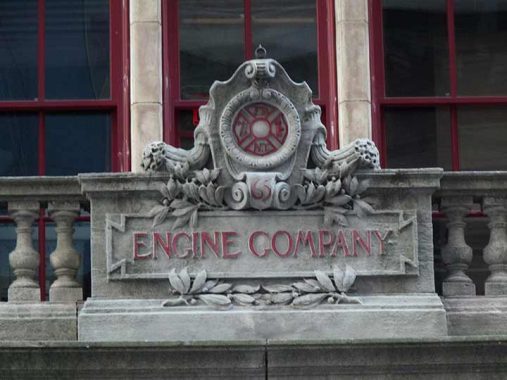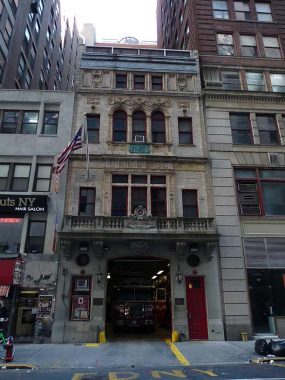
In an area rich with architectural gems like the Yale Club, General Society of Mechanics and tradesmen and the Algonquin Hotel, all on West 44th, FDNY Engine Company #56, a block south on West 43rd between 5th and 6th Avenues slots right in. As its Landmarks Preservation Commission report has it:
Erected in 1897-98, the Fire Engine Company No. 65 firehouse was built to increase fire protection in an almost unprotected yet increasingly fashionable neighborhood. Its construction came at the end of a decade of extensive redevelopment which transfo:nned service-oriented West 43rd Street between Fifth and Sixth avenues into a locus of prestigious hotels and club buildings. Its largely intact, stately facade is the result of professional developments in the New York Fire Department during the nineteenth century.
|
The graceful proportions and Renaissance-inspired vocabulary of the exterior are derived, for the most part, from the Beaux-Arts architecture of the influential 1893 World’s Columbian Exposition in Chicago. Designed by the young firm of Hoppin & Koen, the Fire Engine Company No. 65 firehouse is a transitional design between the earlier, picturesque firehouses by the finn of Napoleon I.eBrun (later N. I.eBrun & Sons) and the later, standardized neo- Georgian modular scheme by Hoppin & Koen that was executed throughout the city after 1910.
|
Several years after designing the Fire Engine Company No. 65 firehouse, the firm was responsible for another Beaux-Arts style civic edifice, the New York City Police Headquarters Building. At the vanguard of modern fire fighting, Fire Engine Company No. 65, which began with then up- to-date horse-drawn equipment, was the city’s first to use pneumatic tires, a diesel powered pumper, and lime-green colored apparatus. Throughout its long and distinguished history, the company has fought many perilous and costly conflagrations; it continues the heroic task today.

Terra cotta details abound with FDNY initials and representations of salamanders, lizard-shaped amphibians that were believed in legends to be able to withstand fire. The arches are supported by pilasters, or half-columns.

Some more terra cotta, this time trimmed in red, a color found frequently on firehouses. The circular motidf contains representtions of a fire ax and a hydrant.
Try as I might, I had trouble with either the zoom or a shaky hand and could not get a non-blurry image of the copper verdigris nameplate with the fire commissioner, architect and date construction began, 1898. (Roman numerals were so unwieldy in high numbers that it’s no surprise that Arabic numerals, with the innovation of the zero, took over during the medieval period.)
As always, “comment…as you see fit.” I earn a small payment when you click on any ad on the site. Take a look at the new JOBS link in the red toolbar at the top of the page on the desktop version, as I also get a small payment when you view a job via that link.
6/25/24
